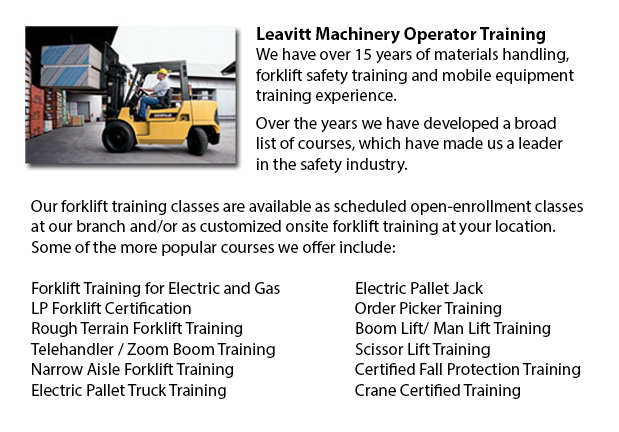
Rough Terrain Forklifts Training St Catharines - There are actually two classifications of lift trucks within the production industry, the rough terrain model and the industrial model. Rough terrain forklifts appeared in the 1940's built predominantly for use on uneven surfaces, perfect for lumberyards and building sites, providing lifting power when there was no paved surface existing.
Rough ground lift trucks usually use an internal combustion engine with a battery for power. The engines are able to operate on propane, diesel or gas. A number of manufacturers are experimenting with rough ground lift trucks that make use of vegetable matter and run from ethanol. Huge pneumatic tires with deep treads characterize these forklifts to permit them to latch onto the roughest ground type devoid of any slippage or sliding.
The earliest styles of all terrain lift trucks were able to carry weights of up to 1000 lbs, via blades that could run under the item, raise it a slight bit and then move it to another location. After a decade on the market, rough terrain lift trucks had been given supplementary shipping strength to about 2000 lbs capacity. Telescoping booms were added in the 1960's, allowing them to stack resources much higher than in previous years. The telescoping design feature is a staple of nearly all rough terrain forklifts nowadays. Present versions are capable of managing well over 4000 lbs thanks to the constant enhancements through the years. Telescoping capability has additionally improved with some styles attaining a height of 35 feet. Worker safety has also become a focus with many rough terrain forklifts now designed are outfitted with an enclosed cab for the operator, as opposed to the older open air seating capacity.
The all terrain lift trucks available today work just as well on covered floors as on unpaved roads. These all terrain lift trucks are being marketed for their versatility allowing organizations to transfer parts from outside the facility to the inside or vice versa.
-
JLG Telehandler
JLG Telehandler Training St Catharines - In the late 1960's John L. Grove, with his wife Cora embarked on on a cross country trip in their RV. Newly retired, after spending several years working with his brother to assemble their crane company into a... More -
Scissor Pallet Trucks
Scissor Pallet Truck Training St Catharines - Scissor lift pallet trucks are created to have the ability to move and stack pallets with a built-in lifting device that permits the pallets to be elevated. This equipment is very functional for working... More -
Pallet Lifts
Pallet Lifts Training St Catharines - A pallet jack is a piece of equipment dedicated in the moving of pallets of many dimensions and weights. They can be used as an appendage for platform lifts, cranes and other types of heavy machinery or be utiliz... More -
Scissor Lifts
Scissor Lift Training St Catharines - The scissor lift or table lift, is a mechanical industrial lift that has been tailored to be utilized in retail, wholesale, manufacturing and production settings. Mechanized scissor lifts have been used chiefly w... More -
Clark Forklift
Clark Forklift Forklift Training - At this time, there are over 350,000 Clark lift trucks performing worldwide, and more than 250,000 in service in North America alone. With five main lines across the world, Clark is proud to be one of the most expan... More

Forklift Certification St Catharines
TOLL FREE: 1-888-254-6157
St Catharines, Ontario
forkliftcertificationstcatharines.com/
Email Us
About Us


